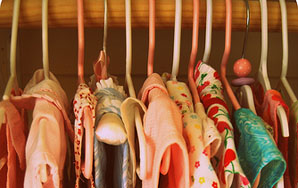The Beauty Of Imperfection
Recently it occurred to me to ask myself -- what is underlying this paranoia? Will the universe really grind to a screeching halt on its axis if I have a dot of ink one micrometer in diameter on my dress?

When I was an impressionable young English major reading the Divine Comedy, we were introduced to the concept of the contrapasso for the first time in our brief literary careers. A contrapasso, in Dante’s Inferno (and to a lesser extent the Purgatorio), is the punishment of a soul by a process either resembling or contrasting with the sin itself. In other words, God doles out uniquely suitable punishments to Dante’s sinners in the afterlife depending on what their pet foibles in life were. The lustful, blown about by the winds of passion in life, chase each other aimlessly in a violent thunderstorm, the angry are found mud-wrestling in the Styx, and the lifetime bullshitters are steeped in excrement for all time. And so forth.
Somewhere around Canto XXII the question came up in the cafeteria at lunch one day what my own contrapasso in the afterlife would be. It stumped my classmates for a few minutes. (Today it wouldn’t have taken them as long; I have more vices now. I was far less interesting in college.) Finally, one friend chimed in: Oh, I know, that’s easy. Donna’s contrapasso would be to spend all eternity without an iron or any Spray’n’Wash.
I froze in my chair — horrified — prompting a chorus of chuckles around the table. You see, I have OCD. And I’m not bandying the term about recklessly like those psych major wannabes who now work in sales development but who want to diagnose every socially awkward person they meet at a cocktail party with Asperger’s syndrome. I actually am clinically obsessive-compulsive. Sadly, my OCD doesn’t manifest itself in any useful ways, like being able to keep my room from looking like a bookstore threw up on it, or remembering to file my income tax return before the apocalypse occurs.
How it does manifest itself is in cognitive compulsions, mental obsessions, and some deeply-rooted idiosyncratic quirks that only those very close to me ever notice. For example, I obsessively edit my emails and Facebook messages, rewrite them dozens of times. Chances are if you’ve ever gotten an inbox message from me that was longer than a couple sentences, I spent literally two or three hours agonizing over it, trying to phrase it just perfectly. I go apesh-t bonkers when people move my stuff, not because I care that they touched/borrowed it but because it’s two inches to the left of where I expected to find it. I have to re-light a cigarette several times if I feel it is not burning evenly, or is burning in an aesthetically less-than-pleasing fashion. I have to eat all my food in carefully regimented order (because life as we know it would end if I had to eat a bite of green beans, then a bite of chicken, then return to the green beans). And most importantly of all, I hate HATE HATE wrinkles and stains.
I have been known to throw out perfectly good clothing because it was wrinkly and I didn’t have immediate access to an iron. I have hidden in the back of my closet forever a dress with a near-invisible ink stain on it (we’re talking a microscopic speck), another with a teensy-tiny burn hole, and still another with a slightly pulled stitch at the hem. My little sister calls such imperfections “Donna-stains,” since no one else can see them. And yet — and yet — I refuse to wear those articles of clothing, and if I do notice such a thing on my person it will bother me all freaking day and is literally all I will think about. (I’m not kidding. One time I cried so hard in the car over an uneven loose thread on a scarf I was wearing that my then-boyfriend had to pull over and buy me scissors at CVS so that I could fix it.)
Recently it occurred to me to ask myself — what is underlying this paranoia? Will the universe really grind to a screeching halt on its axis if I have a dot of ink one micrometer in diameter on my dress? It seems that the clear and obvious answer is a near-pathological (okay, downright pathological) inability to tolerate imperfection of any kind.
But imperfection is beauty, as Marilyn Monroe once observed (and as one of history’s most beautiful and imperfect people, she would know). The Mona Lisa doesn’t have eyebrows. The Venus de Milo doesn’t have arms. In Norman Rockwell’s People Reading Stock Exchange, he famously gave a kid a third leg, but the painting is still iconic. Fahrenheit 451 is not actually the autoignition point of paper, but the book endures. The real Pocahontas was 12 and probably not banging John Smith, but “Colors of the Wind” is still gorgeous. We distress our jeans and shabby-chic our apartments, and the books we love the best are the one with the dog-eared pages and the Chinese food stains at the corners.
I remember a friend of mine’s guitar strap breaking onstage once during a dress rehearsal of a show we all loved, the incident resulting in the guitar clattering to the ground and a rather nasty gash down the front of the instrument. “It’s all right,” the actor said. “Whenever I look at it now, I’ll remember I got this doing something I love.” Can we not say the same of the scars and stretchmarks on our own lives? The Japanese have embraced this concept: they call it wabi-sabi, which has no literal English translation. It is the art of finding beauty in imperfection, of valuing real, raw, gritty authenticity over technical perfection and lavish ornamentation. “Broadly speaking,” writes Robyn Griggs Lawrence, the editor-in-chief of Natural Home:
“Wabi-sabi is everything that today’s sleek, mass-produced, technology-saturated culture isn’t. It’s flea markets, not shopping malls; aged wood, not swank floor coverings; one single morning glory, not a dozen red roses. Wabi-sabi understands the tender, raw beauty of a gray December landscape and the aching elegance of an abandoned building or shed. It celebrates cracks and crevices and rot and all the other marks that time and weather and use leave behind. To discover wabi-sabi is to see the singular beauty in something that may first look decrepit and ugly… Bringing wabi-sabi into your life doesn’t require money, training, or special skills. It takes a mind quiet enough to appreciate muted beauty, courage not to fear bareness, willingness to accept things as they are — without ornamentation. It depends on the ability to slow down, to shift the balance from doing to being, to appreciating rather than perfecting.
What would that even look like — to finally and for good let go of all the expectations, of all the endless dog-chasing-tail frustrations of the perfectionism cycle? How can we all inculcate more wabi-sabi into our own lives, and foster it in the lives of those around us?
Today I challenge myself to go ahead and wear — and wear with pride — those ten-year-old jeans I love so much, the ones with the flecks of paint at the knees I got from building a set – from doing what I loved. Maybe I can tolerate a few wrinkles here and there in my T-shirts, as I’ve no time to waste anymore crying over an ironing board when I have a life to be lived. I’m going to a wedding this afternoon, and maybe I’ll even haul out of the closet that dress with the invisible ink spot — the ink spot I no doubt got from writing a note to someone I loved. Can these stains and wrinkles even be called imperfections? Or are they simply physical evidence of a life lived out loud?
If so, then Marilyn was right; imperfection is beauty. So live out loud, and make choices today that spill some ink and rip some denim, because those are the only choices, in the end, worth making. ![]()




